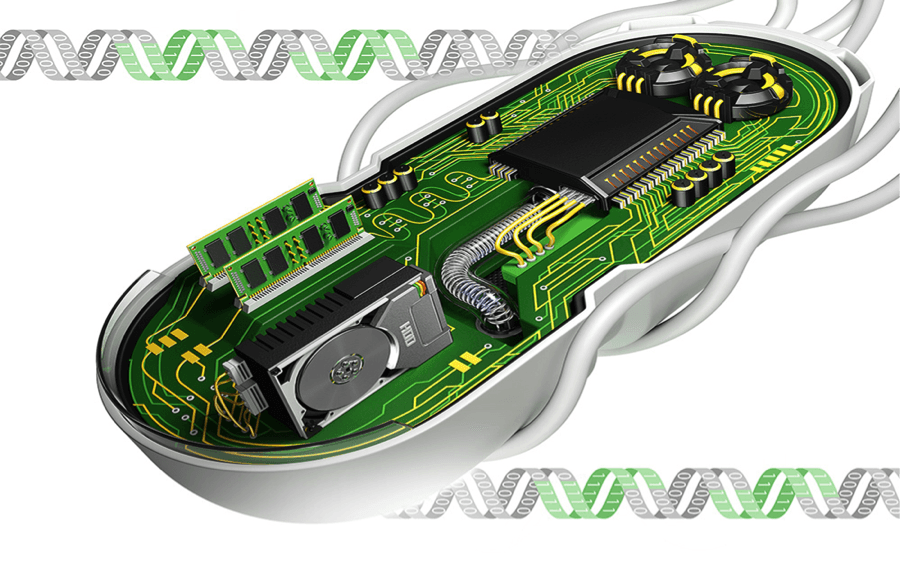
Scientists like Dr. Lu at MIT are combining electrical engineering principles with biology, viewing cells as “state machines” Image credit to Liang Zong and Yan Liang. Published with permission from MIT News Office.
A recent article in ScienceDaily reviews a new approach in Synthetic Biology that allows cells to respond to a series of input stimuli and simultaneously remember the order of these stimuli over many generations (1).
As noted by the senior investigator, Timothy Lu from MIT, combining computation with memory creates complex cellular circuits that can perform logic functions and store memories of events by encoding them in their DNA (1,2). In their current work, Dr. Lu and his colleagues created cells that can remember and respond to three different inputs, including chemical signals in a particular order, and in the future may be able to incorporate even more inputs (1,2,3). The cellular machines thus created are referred to as biological “state machines” because they exist in different states depending on the identity and order of inputs that they receive. The state machines rely on enzymes called recombinases. When activated by a specific input, recombinases either delete or invert a particular segment of DNA depending on the orientation of two DNA target sequences known as recognition sites. The segment of DNA between these sites may have recognition sites for other recombinases that respond to different inputs. Flipping or deleting these sites permanently changes what will happen if a second or third recombinase is later activated. Therefore, a cell’s history is determined by sequencing its DNA. In a version of this system with just two inputs, there are five possible states for this circuit: states corresponding to (1) no input, (2) input A alone, (3) input B alone, (4) A followed by B, and (5) B followed by A. Dr. Lu’s team in MIT has designed and built circuits that record up to three inputs, in which sixteen states are possible (1,2).
Besides creating circuits that record events in a cell’s life and then transmit these memories to future generations, the researchers from MIT also placed genes into the array of recombinase binding sites along with genetic regulatory elements. In these circuits, when recombinases rearrange the DNA, the circuits record the information as well as control which genes get turned on and off. Lu’s lab tested this work in bacteria by color coding the identity and order of input stimuli, so input A followed by B would would lead to bacteria fluorescing red and green, but input B followed by A would lead to red and blue fluorescence. Hence, these techniques can be used not only to record the states that the cells experience over time, but also to deploy in state-dependent gene expression programs (1,2).
This novel technique of cell circuit logic aided by memory could have significant utility in future scientific research. Currently, much is known about the factors that regulate differentiation of specific cell types or lead to progression of certain diseases, but not much is known about the temporal organization of these factors that may lead to disease progression (1). Dr. Lu’s techniques help study processes that are controlled by a series of events in which the temporal order of events may matter, such as the appearance of cytokines or other signaling molecules. For instance, a recent study has shown that the order of mutation acquisition can determine how cancer cells develop into tumors and even how they respond to drugs (1). Thus, with the use of cell circuits that track memory, potential future applications may include tracking the trajectory of stem cells or other immature cells into differentiated mature cells and even monitoring the progression of diseases such as cancer.
Image credit to Liang Zong and Yan Liang. Published with permission from MIT News Office.
Image Sentence: Scientists like Dr. Lu at MIT are combining electrical engineering principles with biology, viewing cells as “state machines”.
Image Source: https://www.google.com/search?q=Engineering+technology+helps+cells+remember+and+respond+to+events&biw=807&bih=614&site=webhp&source=lnms&tbm=isch&sa=X&ved=0ahUKEwi09-Hk5ZnOAhXI24MKHWYXBWwQ_AUIBygC&dpr=1#imgrc=VxqgD4NQcV4EGM%3A
References:
1. Massachusetts Institute of Technology. “Scientists program cells to remember and respond to series of stimuli: New approach to biological circuit design enables scientists to track cell histories.” ScienceDaily. ScienceDaily, 21 July 2016. <www.sciencedaily.com/releases/2016/07/160721151225.htm>.
2. Anne Trafton. “Cell circuits remember their history: MIT engineers design new synthetic biology circuits that combine memory and logic.” MIT News. MIT News, 10 Feb 2013. <www.sciencedaily.com/releases/2016/07/160721151225.htm>.
3. Nathaniel Roquet, Ava P. Soleimany, Alyssa C. Ferris, Scott Aaronson, Timothy K. Lu. Synthetic recombinase-based state machines in living cells. Science, 2016 DOI: 10.1126/science.aad8559

Leave a Reply